|
|
|
Sort Order |
|
|
|
Items / Page
|
|
|
|
|
|
|
| Srl | Item |
| 1 |
ID:
125113
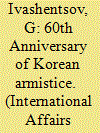

|
|
|
|
|
| Publication |
2013.
|
| Summary/Abstract |
ON JULY 27, 2013, it will be 60 years since the Armistice Agreement was signed in the village of Panmunjom, putting an end to the three-year Korean War. That war, which has become the bloodiest and most devastating military conflict since the end of World War II, remains an unhealed wound for the Koreans while its consequences are still making an impact on the international situation in Northeast Asia and beyond.
|
|
|
|
|
|
|
|
|
|
|
|
|
|
|
|
| 2 |
ID:
139069


|
|
|
|
|
| Summary/Abstract |
In consideration of the great symbolism of the year 2015, we are publishing the Summer 2015 issue of The Korean Journal of Defense Analysis as a special issue on the 70th anniversary of the end of WWII. We in the Editorial Committee of the KJDA would like to express our heartfelt thanks to distinguished professors, researchers, experts, and readers for their recognition of our work on this edition and their efforts to collaborate with us.
|
|
|
|
|
|
|
|
|
|
|
|
|
|
|
|
| 3 |
ID:
140683
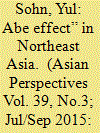

|
|
|
|
|
| Summary/Abstract |
IN DECEMBER 2012 ABE SHINZO RETURNED TO POWER AFTER FIVE years in the political wilderness. Since taking office he has solidified his political leadership by winning all successive elections, paving the way to becoming one of the longest tenured premiers in postwar Japan. His security and foreign policies have already changed the landscape of international relations in East Asia as Tokyo’s relations with Seoul and Beijing spiraled down to new lows for the post–Cold War era. Abe’s new security policy, under the slogan “Proactive Contribution to Peace,” helped bring the Japan-US alliance to an unprecedented level of closeness, clearly pitted against China. The Abe government is also potentially challenging the China-centered new economic order by promoting the US-led Trans-Pacific Partnership (TPP) trade network. Abe’s decision to enter the TPP talks became a game changer in the race for free trade agreements in Asia and the Pacific.
|
|
|
|
|
|
|
|
|
|
|
|
|
|
|
|
| 4 |
ID:
055667
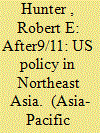

|
|
|
| 5 |
ID:
118937
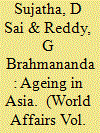

|
|
|
| 6 |
ID:
076124
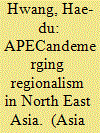

|
|
|
| 7 |
ID:
071615


|
|
|
|
|
| Publication |
2006.
|
| Summary/Abstract |
During the immediate aftermath of the 1997 ASEAN crisis, instead of promoting a further "deepening" of the integration process, ASEAN has preferred enlarging its membership and has opened up to its Northeast Asian partners, Japan, China and South Korea. The mounting economic trade flows among those actors necessitates calls for the coherent creation of effective regional structures. China in particular, among the three mentioned countries, has come to the fore with its diplomatic strategies concerning the regional architecture. As results of these recent changes, the structure of power and the nature of the regional system are altering and ASEAN is going through a decisive transition. Taking into consideration the speed of the evolving framework with the enlargement of an East Asian Community, ASEAN would need a new political vision for the region, for the redefinition of its internal balance of power and for the elaboration of a clear approach toward external partners. Crucial problems affect the entire area such as deficit of democracy, wide development gaps among the East Asian countries, the widespread need for economic liberalisation and need for new human and regional security policies. The EU would play a fundamental role in addressing these problems and would be well inspired to avoid considering Southeast Asia as just a mere periphery of China.
|
|
|
|
|
|
|
|
|
|
|
|
|
|
|
|
| 8 |
ID:
077278
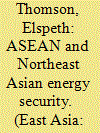

|
|
|
| 9 |
ID:
109261


|
|
|
| 10 |
ID:
143016
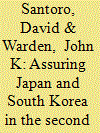

|
|
|
|
|
| Summary/Abstract |
Discussions about the requirements for U.S. extended deterrence and assurance are making a comeback. During the Cold War, U.S. analysts focused primarily on Western Europe, but in recent years the challenges of extended deterrence and assurance have been starker in Northeast Asia. Discussing the requirements for U.S. extended deterrence and assurance involves asking how the United States can deter its adversaries and assure its allies. In both cases, the critical factor is perception. According to analysts Clark Murdock and Jessica Yeats, “In the same way that deterrence must be tailored to each actor, situation, and form of warfare, assurance must be tailored to the strategic culture, threat perceptions, values, and specific concerns of each ally.”
|
|
|
|
|
|
|
|
|
|
|
|
|
|
|
|
| 11 |
ID:
088755


|
|
|
|
|
| Publication |
Canberra, Department of Defence, 1997.
|
| Description |
vi, 66p.
|
| Series |
Australia's Strategic Policy
|
| Standard Number |
0644370009
|
|
|
|
|
|
|
|
|
|
|
|
Copies: C:1/I:0,R:0,Q:0
Circulation
| Accession# | Call# | Current Location | Status | Policy | Location |
| 039505 | 355.40994/AUS 039505 | Main | On Shelf | General | |
|
|
|
|
| 12 |
ID:
074746


|
|
|
|
|
| Publication |
2006.
|
| Summary/Abstract |
This paper examines Japanese and South Korean host-nation support (HNS) policies toward American forces deployed in those two countries from a comparative perspective. It finds that both countries provide substantial support for US forces, contrary to the expectations of collective action theory and the assumptions of many international relations theorists about free-riding. Northeast Asian HNS support tends to be both quantitatively substantial and to involve an unusually elaborate range of common support programs, thus constituting a distinctive Northeast Asian model of “burden-sharing.” The specific programs supporting US forces in these two countries were generally designed by local politicians and bureaucrats, with only minimal input from the US, albeit under American pressure. They were implemented in discontinuous fashion, at critical junctures, as during the Gulf War and the first Korean nuclear crisis. These results thus provide useful elaboration of “reactive state” and “critical juncture” interpretations of how East Asian policymaking relates to domestic and international politics.
|
|
|
|
|
|
|
|
|
|
|
|
|
|
|
|
| 13 |
ID:
123704
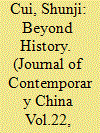

|
|
|
|
|
| Publication |
2013.
|
| Summary/Abstract |
This article takes the proposition that cooperation in the area of non-traditional security (NTS) can provide the essential window of opportunity for Northeast Asians to move beyond history. To demonstrate, it explores the development of NTS cooperation in Northeast Asia, paying particular attention to Sino-Japanese cooperation in the environmental and disaster areas. It then examines the relationship between NTS cooperation and the construction of a regional international society in Northeast Asia. It argues that the importance of NTS cooperation is twofold. First, in a region where historical animosities remain high, NTS issues can avoid sensitive areas and find common ground for cooperation that traditional security approaches would be unable to envisage. Second, NTS cooperation has turned people-to-people relations in a more prominent and conciliatory direction, and enhanced human security consideration, thus taking things further than the indirect consequences of functionalism.
|
|
|
|
|
|
|
|
|
|
|
|
|
|
|
|
| 14 |
ID:
046702
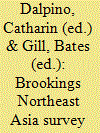

|
|
|
|
|
| Publication |
Washington,D.C., Brookings Institutions Press, 2002.
|
| Description |
x, 119p.
|
|
|
|
|
|
|
|
|
|
|
|
Copies: C:1/I:0,R:0,Q:0
Circulation
| Accession# | Call# | Current Location | Status | Policy | Location |
| 045794 | 327.5003/DAL 045794 | Main | On Shelf | General | |
|
|
|
|
| 15 |
ID:
094149
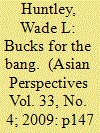

|
|
|
| 16 |
ID:
078221
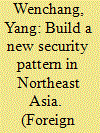

|
|
|
| 17 |
ID:
160758
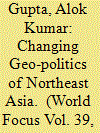

|
|
|
|
|
| Summary/Abstract |
The geopolitical landscape of Northeast Asia is changing owing to shifting strategic and political dynamics on the Korean peninsula. Hectic diplomacy is happening involving directly South Korea, North Korea and United States and indirectly China and Russia. South Korean President Moon Jae-In is as dynamic and forward looking as Indian Prime Minister Narendra Modi.
|
|
|
|
|
|
|
|
|
|
|
|
|
|
|
|
| 18 |
ID:
073539
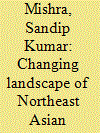

|
|
|
|
|
| Publication |
2006.
|
| Summary/Abstract |
While the six-party talks about the North Korean nuclear programme seem to have come to a standstill, Sandip Kumar Mishra points out the relations between the two Koreas have significantly improved while South Korea has grown closer to China and to Japan, despite periodic frictions. The "peaceful rise" of China as the dominant power is causing alarm in Tokyo and Washington, prompting Japan to build up its military might. Taiwan on the other hand, seems to grow ever more dependent on China.
|
|
|
|
|
|
|
|
|
|
|
|
|
|
|
|
| 19 |
ID:
110070
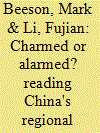

|
|
|
|
|
| Publication |
2012.
|
| Summary/Abstract |
China has rapidly re-emerged as a major regional power in East Asia. Although this represents a return to a long-established historical pattern, the ability of China's political elites to reassure nervous neighbours about the implications of its rise will be a major test of its evolving and increasingly sophisticated foreign policies. In this paper we focus primarily on China's regional engagement strategies, detailing the way such initiatives are understood in China, and the way they are received elsewhere. We focus primarily on the political and economic impacts of China's policies, and briefly consider their reception in Northeast Asia and Southeast Asia. We highlight the different dynamics and issues that China's policymakers must consider in each area, and suggest that despite some difficulties and tensions, on balance, China's policies are proving surprisingly effective.
|
|
|
|
|
|
|
|
|
|
|
|
|
|
|
|
| 20 |
ID:
104767


|
|
|
|
|
| Publication |
2011.
|
| Summary/Abstract |
Divergent responses to the sinking of the ROKS Cheonan and the shelling of Yeonpyeong Island in 2010 have raised tensions in Northeast Asia. China's enabling response appeared to write North Korea a blank cheque for further provocations; but Beijing has in fact been constrained by fear of destabilisation of the Kim regime. The incidents have prompted a reappraisal of bilateral relations within the region - in particular, the South Korea-US alliance - and revealed the continuing importance of the Sino-US relationship in Korean peninsular security affairs.
|
|
|
|
|
|
|
|
|
|
|
|
|
|
|
|
|
|
|
|
|